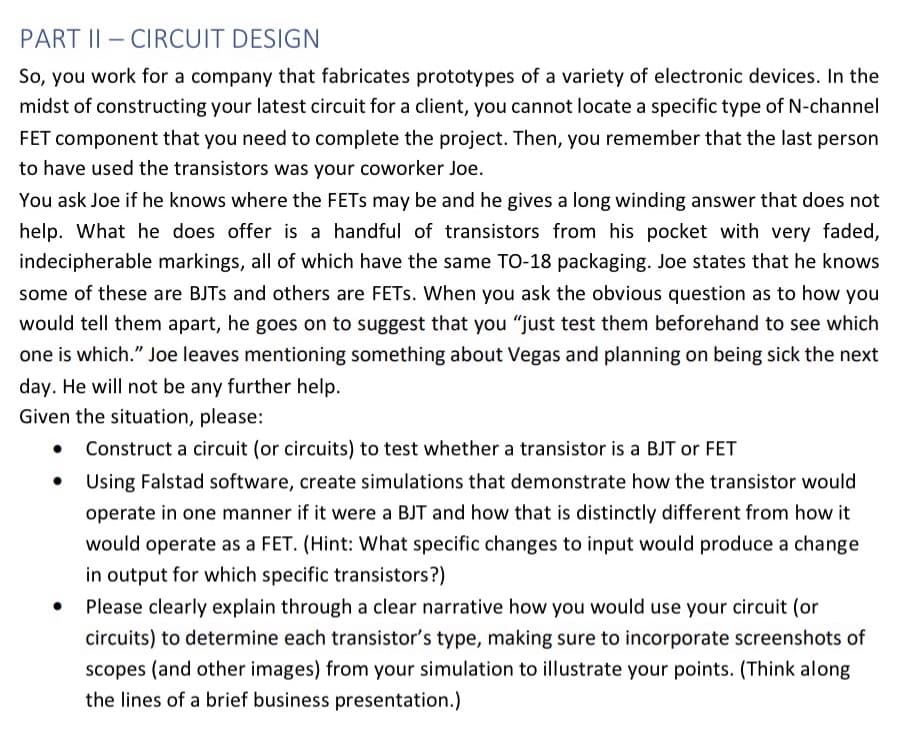PART II-CIRCUIT DESIGN So, you work for a company that fabricates prototypes of a variety of electronic devices. In the midst of constructing your latest circuit for a client, you cannot locate a specific type of N-channel FET component that you need to complete the project. Then, you remember that the last person to have used the transistors was your coworker Joe. You ask Joe if he knows where the FETS may be and he gives a long winding answer that does not help. What he does offer is a handful of transistors from his pocket with very faded, indecipherable markings, all of which have the same TO-18 packaging. Joe states that he knows some of these are BJTS and others are FETs. When you ask the obvious question as to how you would tell them apart, he goes on to suggest that you "just test them beforehand to see which one is which." Joe leaves mentioning something about Vegas and planning on being sick the next day. He will not be any further help. Given the situation, please: • Construct a circuit (or circuits) to test whether a transistor is a BJT or FET Using Falstad software, create simulations that demonstrate how the transistor would operate in one manner if it were a BJT and how that is distinctly different from how it would operate as a FET. (Hint: What specific changes to input would produce a change in output for which specific transistors?) Please clearly explain through a clear narrative how you would use your circuit (or circuits) to determine each transistor's type, making sure to incorporate screenshots of scopes (and other images) from your simulation to illustrate your points. (Think along the lines of a brief business presentation.)
PART II-CIRCUIT DESIGN So, you work for a company that fabricates prototypes of a variety of electronic devices. In the midst of constructing your latest circuit for a client, you cannot locate a specific type of N-channel FET component that you need to complete the project. Then, you remember that the last person to have used the transistors was your coworker Joe. You ask Joe if he knows where the FETS may be and he gives a long winding answer that does not help. What he does offer is a handful of transistors from his pocket with very faded, indecipherable markings, all of which have the same TO-18 packaging. Joe states that he knows some of these are BJTS and others are FETs. When you ask the obvious question as to how you would tell them apart, he goes on to suggest that you "just test them beforehand to see which one is which." Joe leaves mentioning something about Vegas and planning on being sick the next day. He will not be any further help. Given the situation, please: • Construct a circuit (or circuits) to test whether a transistor is a BJT or FET Using Falstad software, create simulations that demonstrate how the transistor would operate in one manner if it were a BJT and how that is distinctly different from how it would operate as a FET. (Hint: What specific changes to input would produce a change in output for which specific transistors?) Please clearly explain through a clear narrative how you would use your circuit (or circuits) to determine each transistor's type, making sure to incorporate screenshots of scopes (and other images) from your simulation to illustrate your points. (Think along the lines of a brief business presentation.)
Delmar's Standard Textbook Of Electricity
7th Edition
ISBN:9781337900348
Author:Stephen L. Herman
Publisher:Stephen L. Herman
Chapter33: Single-phase Motors
Section: Chapter Questions
Problem 1PA
Related questions
Question

Transcribed Image Text:PART II-CIRCUIT DESIGN
So, you work for a company that fabricates prototypes of a variety of electronic devices. In the
midst of constructing your latest circuit for a client, you cannot locate a specific type of N-channel
FET component that you need to complete the project. Then, you remember that the last person
to have used the transistors was your coworker Joe.
You ask Joe if he knows where the FETS may be and he gives a long winding answer that does not
help. What he does offer is a handful of transistors from his pocket with very faded,
indecipherable markings, all of which have the same TO-18 packaging. Joe states that he knows
some of these are BJTS and others are FETs. When you ask the obvious question as to how you
would tell them apart, he goes on to suggest that you "just test them beforehand to see which
one is which." Joe leaves mentioning something about Vegas and planning on being sick the next
day. He will not be any further help.
Given the situation, please:
• Construct a circuit (or circuits) to test whether a transistor is a BJT or FET
Using Falstad software, create simulations that demonstrate how the transistor would
operate in one manner if it were a BJT and how that is distinctly different from how it
would operate as a FET. (Hint: What specific changes to input would produce a change
in output for which specific transistors?)
Please clearly explain through a clear narrative how you would use your circuit (or
circuits) to determine each transistor's type, making sure to incorporate screenshots of
scopes (and other images) from your simulation to illustrate your points. (Think along
the lines of a brief business presentation.)
Expert Solution
This question has been solved!
Explore an expertly crafted, step-by-step solution for a thorough understanding of key concepts.
Step by step
Solved in 2 steps with 7 images

Recommended textbooks for you

Delmar's Standard Textbook Of Electricity
Electrical Engineering
ISBN:
9781337900348
Author:
Stephen L. Herman
Publisher:
Cengage Learning

Delmar's Standard Textbook Of Electricity
Electrical Engineering
ISBN:
9781337900348
Author:
Stephen L. Herman
Publisher:
Cengage Learning